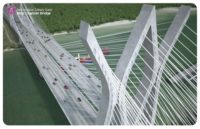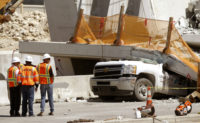Design Review Finds Concerns on $962M Houston Bridge

An October 2019 shot of the jump form assembly for the Houston Ship Channel Bridge's southbound M4 pylon.
Photo courtesy Harris County Toll Road Authority
A third-party design review of the under-construction Houston Ship Channel bridge project indicates numerous areas of concern, according to a report released by the Harris County (Texas) Toll Road Authority (HCTRA).
In January, the authority had halted construction of the $962-million bridge—designed by FIGG Bridge Engineers—after an initial review uncovered an issue related to design of the curved portions of the main pylons’ legs on the bridge’s cable-stayed segment.
The review by COWI North America found 21 areas of “significant concern,” according to a letter submitted to county commissioners by HCTRA Executive Director Peter W. Key. According to the report, COWI found the wind loading used—during both the construction period and while in service—to be “unreliable,” and recommended multiple changes.
The bridge’s curved leg regions remain a concern, as COWI found that they “do not have the required capacity.”
Another concern identified by the report, was that “traffic load on the [southbound] structure has not been considered in the contractor's analysis for [northbound] structure erection.”
Findings related to design of the bridge’s foundations included: pile geotechnical capacities that were found to “not meet the project requirements at any of the foundations” and “pylon pile cap structural capacities [that] do not meet the project requirements for strength.”
HCTRA presented COWI's report to the Harris County Commissioners Court on March 10. During the meeting, County Commissioner Adrian Garcia asked whether these issues would have been found without bringing in an independent, third-party firm. Key, who was on hand to answer questions on behalf of HCTRA, said, "probably not."
Key recommended to commissioners that the agency authorize FIGG and COWI to work together to resolve the issues. A statement from FIGG indicates the firm was not surprised by the report.
“Reviews are common in the bridge engineering profession, and it is typical for engineering analyses from two companies to have differences,” the statement read. “It was fully expected that there would be some comments to address. FIGG looks forward to the next stage of this process where all the engineering companies on the design team will be able to collaborate in reviewing any comments.”
HCTRA noted in a March 11 statement that the construction pause initiated in January will "continue indefinitely in order to allow the engineer of record (FIGG) and the independent consultant (COWI) an opportunity to work jointly."
"Projects of that critical nature demand the utmost in safety. I've now been at the county a long time. I've never seen the county be callous or cavalier towards projects. Safety's always in people's minds," Key told county commissioners. "But this project is unique with regards to the critical nature of the project itself, where it sits and the dollar values associated with it. So it was absolutely appropriate to do this report."
HCTRA plans to update county commissioners "as soon as practical” regarding timing and costs.






